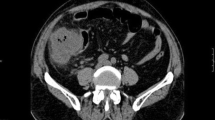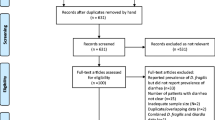Summary
1. Of 14,000 patients studied over a period of 6 years, 2.4% were infected withD. fragilis. The majority were U. S. citizens who had not traveled out of the country.
2. The 100 cases of “pure” infection withD. fragilis are summarized.
3. Diagnosis was made by direct examination of recently passed loose stools combined with culture.
4. The most frequent presenting symptoms were abdominal pain, diarrhea, flatus, nausea, vomiting, and fatigue.
5. Physical signs, proctoscopic examination, and radiologic study usually were negative.
6. Treatment eliminated the parasite although evaluation of symptomatic relief was often difficult.
7.D. fragilis is considered by many to be nonpathogenic and is often ignored. Such appears unjustified in view of cases reported in the literature and cases reviewed. Specific therapy seems warranted.
Similar content being viewed by others
References
Jepps, M. W., andDobell, C. Dientamoeba fragilis, n. g. n.w., a new intestinal amoeba from man.Parasitology 10:352, 1918.
Dobell, C. The Ameba Living in Man. Wm. Wood and Co., New York, 1919.
Wenyon, C. M., andO'Connor, F. W. Human Intestinal Protozoa in the Near East. London, 1917.
Svensson, R. A survey of human intestinal protozoa in Sweden and Finland (A preliminary report).Parasitology 20: 237, 1928.
Brug, S. L. Observations on D. fragilis.Ann Trop Med Parasit 30:441, 1936.
Stabler, R. M. Intestinal protozoa in 106 parasitology students.J Parasit 27:90, 2941.
Wenrich, D. H., Stabler, R. M., andArnett, J. H. E. histolytica and other intestinal protozoa in 1060 college freshmen.Amer J Trop Med 15:331, 1935.
Wenrich, D. H., andArnett, J. H. Results of a protozoological survey of food handlers at a professional school in Philadelphia, Pennsylvania.Amer J Trop Med 22:102, 1942.
Hood, M. Diarrhea caused by D. fragilis.J Lab Clin Med 25:914, 1940.
Sapero, J. J. Clinical studies in non-dysenteric intestinal amebiasis.Amer J Trop Med 19:497, 1939.
Talis, B., andStein, B. The presence of D. fragilis in the gallbladder.Harefuah 61:125, 1963.
Tumka, A. F. Two cases of isolation of D. fragilis and the problem of species independence of these amebae.Med Parazet (Moskva)32:9, 1963.
Gittings, I. C, andWaltz, A. D. D. fragilis.Amer J Dis Child 34:542, 1927.
Mollari, M, andAnzulovic, N. V. Cultivation and pathogenicity of D. fragilis with a case report.J Trop Med 4:246, 1938.
Knoll, E. W., andHowell, K. M. Studies on D. fragilis. Its incidence and possible pathogenicity.Amer J Clin Path 15:178, 1945.
Hakansson, E. G. D. fragilis, a cause of illness. Report of a case.Amer J Trop Med 16:175, 1936.
Hakansson, E. G. D. fragilis, some further observations.Amer J Trop Med 17:349, 1937.
Hakansson, E. G. The use of aqueous smears in the study and identification of the amebae of man.Amer J Trop Med 15:439, 1935.
Wenrich, D. H. Studies on D. fragilis (Protozoa). IV. Further observations with an outline of present day knowledge of this species.J Parasit 30:322, 1944.
Burrows, R. B., andSwerdlow, M. A. E. vermicularis as a probable vector of D. fragilis.Amer J Trop Med 5:258, 1956.
Lamy, L. Dientamoeba fragilis, recherche, culture, frequence, interet et caracteres pathogenes.Bull Soc Path Exot 53:505, 1960.
Dobell, C. Researches on the intestinal protozoa in monkeys and Man. X. The life history of D. fragilis: Observations, experiments, and speculations.Parasitology 32:417, 1940.
Keegan, G., and Marsden, P. D. Personal communication, Oct. 8, 1965.
Kudo, R. Observations on D. fragilis.Amer J Trop Med 6:299, 1926.
Swerdlow, M. A., andBurrows, R. B. D. fragilis. An intestinal pathogen.JAMA 158:176, 1955.
Burrows, R. B. et al. Pathology of Dientameba fragilis infections of the appendix.Amer J Trop Med 3: 1033, 1954.
Sapero, J. J., andJohnson, C. M. Incidence of E. histolytica and other intestinal parasites in variously exposed groups of the Navy.U S Naval Med Bull 37:279, 1939.
Rothman, M. M., andLasky, M. Survey of protozoan infection of the staff of a large general hospital.Amer J Med Sci 206:369, 1943.
Brooke, M. M., Donaldson, A. W., Brown, E. An Amebiasis Survey in a Veterans Administration Hospital, Chamblee, Georgia, with Comparison of Technics.Amer J Trop Med 3: 615, 1954.
Brooke, M. M., Heeren, R. H., Sawyer, G. M., Stoner, D. Mass Therapy in Attempted Control of Amebiasis in a Mental Institution.Public Health Rep 73:499, 1958.
Weiner, D., Brooke, M. M., Witkow, A. Investigation of parasitic infections in the central area of Philadelphia.Amer J Trop Med 8:625, 1959.
Melvin, D. M., Brooke, M. M. Parasitologic surveys on Indian reservations in Montana, South Dakota, New Mexico, Arizona, and Wisconsin.Amer J Trop Med 11:765, 1962.
Brooke, M. M., Healy, G. R., Levy, P., Kaiser, R. L., Bunch, W. L. A sample survey of selected areas in and near Little Rock, Arkansas, to assess the prevalence of entamoeba histolytica.Bull World Health Organ 29:813, 1963.
Elsdon-Dew, R. Personal communication, 1964.
Brooke, M. M. Personal communication, 1965.
Brooke, M. M., Gleason, N., Montero-Gei, F. Intestinal parasites in a rural community of Costa Rica.Rev Biol Trop Univ Costa Rica 11:47, 1963.
Svensson, R., andLinders, F. J. The chance of detecting infections with intestinal protozoa.Acta Med Scand 81:267, 1934.
Svensson, R. Studies on human intestinal protozoa, especially with regard to their demonstrability and the connection between their distribution and hygienic conditions.Acta Med Scand Suppl 70:1, 1935.
Author information
Authors and Affiliations
Rights and permissions
About this article
Cite this article
Kean, B.H., Malloch, C.L. The neglected ameba: Dientamoeba fragilis. Digest Dis Sci 11, 735–746 (1966). https://doi.org/10.1007/BF02239427
Issue Date:
DOI: https://doi.org/10.1007/BF02239427




